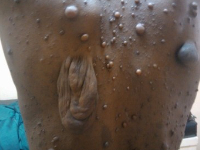An HIV-1 Infected Patient with Neurofibromatosis Type 1: A Case Report
Main Article Content
Abstract
Background: Although HIV-1 infection predisposes an individual to well defined neoplasia, neurofibromas have not been reported as some of the typical ones. The association between HIV-1 infection and neurofibromatosis type 1, a genetic disorder, should be of interest because HIV infection could alter the natural biology of its cutaneous manifestations. However, reports on simultaneous occurrence of these conditions in an individual are rare.
Method: The case records of a 30 year old HIV 1 positive female receiving care at the Jos University teaching hospital centre and a review of the relevant literature was utilised.
Result: We present a 30 year old HIV positive woman with florid cutaneous lesions of familial neurofibromatosis type 1 who had adequate response to antiretroviral therapy
Conclusion: HIV infection and treatment did not seem to affect the clinico- pathological features of the neurofibromatosis lesions
Downloads
Article Details
Section

This work is licensed under a Creative Commons Attribution-NonCommercial-NoDerivatives 4.0 International License.
The Journal is owned, published and copyrighted by the Nigerian Medical Association, River state Branch. The copyright of papers published are vested in the journal and the publisher. In line with our open access policy and the Creative Commons Attribution License policy authors are allowed to share their work with an acknowledgement of the work's authorship and initial publication in this journal.
This is an open access journal which means that all content is freely available without charge to the user or his/her institution. Users are allowed to read, download, copy, distribute, print, search, or link to the full texts of the articles in this journal without asking prior permission from the publisher or the author.
The use of general descriptive names, trade names, trademarks, and so forth in this publication, even if not specifically identified, does not imply that these names are not protected by the relevant laws and regulations. While the advice and information in this journal are believed to be true and accurate on the date of its going to press, neither the authors, the editors, nor the publisher can accept any legal responsibility for any errors or omissions that may be made. The publisher makes no warranty, express or implied, with respect to the material contained herein.
TNHJ also supports open access archiving of articles published in the journal after three months of publication. Authors are permitted and encouraged to post their work online (e.g, in institutional repositories or on their website) within the stated period, as it can lead to productive exchanges, as well as earlier and greater citation of published work (See The Effect of Open Access). All requests for permission for open access archiving outside this period should be sent to the editor via email to editor@tnhjph.com.
How to Cite
References
Huson SM, Compston DAS, Clark P, et al. A genetic study of von Recklinghausen neurofibromatosis in south east Wales: prevalence, fitness, mutation rate, and effect of parental transmission on severity. J Med Genet 1989; 26: 704–11
Atadzhanov M. Hereditary neurological diseases at University Teaching Hospital, Lusaka. neurological diseases. Downloaded on the 6 December, 2011.
Nyandaiti YW, Tahir C, Nggada HA, Ndahi AA. Clinico-pathologic presentation and management ofneurofibromatosis type 1 disease among north-eastern Nigerians: A six year review. Nmj. 2009; 50: 80-83.
Xu GF, O'Connell P, Viskochil D, et al. The neuro?bromatosis type 1 gene encodes a protein related to GAP. Cell 1990; 62: 599–608.
SA Rasmussen, JM Friedman. NF1 Gene and Neurofibromatosis 1. AjE. 2000; 151: 33-39.
Newcomb-Fernandez J. Cancer in the HIV-infected population. Res Initiat Treat Action. 2003; 9: 5-13.
Demopoulos BP, Vamvakas E, Ehrlich JE and Demopoulos R. Non-Acquired Immunodeficiency Syndrome-defining malignancies in patients infected with Human Immunodeficiency Virus. Arch Path Lab Med. 2003; 127: 589-592.
Spano JP, Atlan D, Breau JL, Farge D. AIDS and non-AIDS-related malignancies: a new vexing challenge in HIV-positive patients. Part I: Kaposi's sarcoma, and Hodgkin's lymphoma. Eur J Int Med 13: 170-179, 2002.
Mbulaiteye SM, Biggar RJ, Goedert JJ, Engels EA. Immune deficiency and risk for malignancy among persons with AIDS. J Acquir Immune Defic Syndr 32: 527-533, 2003.
National Institutes of Health Consensus Development Conference Statement: neuro?bromatosis. Arch Neurol 1988; 45: 575–78.
Odebode TO, Afolayan AO, Adigun AI, Daramola OO. Clinicopathological study of Neurofibromatosis type 1: an experience in Nigeria. Int J Derm. 2005; 44: 116-120.
Sivayathorn A, Sriha B, Leesanguankul W. Prevalence of skin diseases in patients with HIV in Bankok, Thailand. Ann Acad Med Singapore. 1995; 24: 528-533.
Leppard B. An Atlas of African Dermatology. Oxon. Radcliffe Medical Press Ltd. 2002: 268-270.
Waugh M. Skin diseases- clinical indicator of immune status in HIV infection. Int J Dermatol 2007;44:705-706

